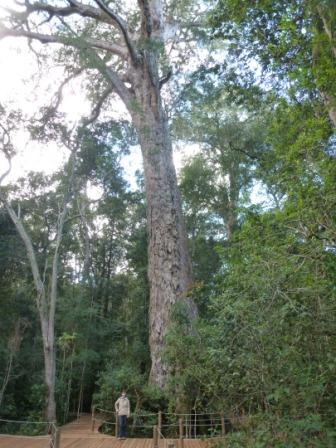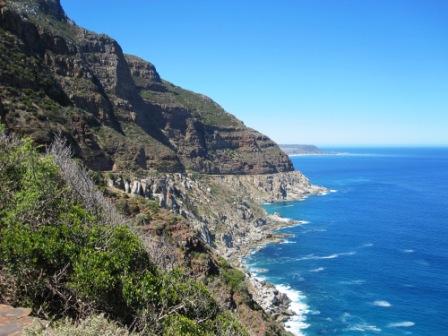Can you see the baboon in this video? He’s well camouflaged – almost impossible to see until he begins to move. My husband and I had been walking through Tsitsikamma, a national park here in South Africa, when we came across a troop of baboons!
No one else was around. Although we had been walking quietly, the baboons heard us coming. They stopped and stared. Were we dangerous? Would we try to steal their food or hurt them? We stood our ground – neither running away nor moving toward them. After a few loud warning calls to us from the dominant male baboon, the troop carried on with their important activity – eating breakfast! That’s when I quietly got out my camera. It was magical watching them in their own habitat. I’m so grateful that the government has preserved this beautiful forested area for animals and people to share.

Here I am standing in front of a Yellow Wood Tree in the Tsitsikamma National Park.
“Preserve” means to keep or to save. And that’s exactly what the South African National Parks (SANParks) service does. This governmental organization preserves land, natural habitats for thousands of plant and animal species. Nobody can build houses, or shopping malls in these areas. Hunting is forbidden. There are strict regulations for visitors so that people and animals can both enjoy these beautiful, natural areas without destroying them.

Suspension bridges link parts of Robberg National Park.
Many of the plants that grow in the areas now preserved as national parks grow nowhere else in the world. So too, many of the animals in these preserved areas are found only here in South Africa. Both common and rare animals are all interconnected in a food web of life, depending on each other for survival.

Eland roam free in Table Mountain National Park, Cape Point.
The United States also has a National Park Service and a National Forest Service, as do many other countries. They too preserve land for plants and animals, educate the public about the importance of taking care of our natural environment, and provide access to natural areas for people to enjoy nature. Governments around the world are beginning to understand the importance of biodiversity. Biodiversity means that there are many different animals (and plants) living in a habitat. That’s important because an environment needs many different types of plants and animals in it for the ecosystem to stay in balance to survive.
It’s good to know that there are governments that understand the importance of preserving habitats to maintain healthy ecosystems.

The ecosystem in False Bay is also protected by the South African government as a marine reserve.

To get to the top of Table Mountain National Park, you ride in a gondola suspended by wire cables. (Animals have to walk up.)

i am happy people are keeping animals from harm
I am glad that there is people out there all over the world trying their best to preserve animals habitats, because without effort, most animals would have nowhere safe to be in the wild.